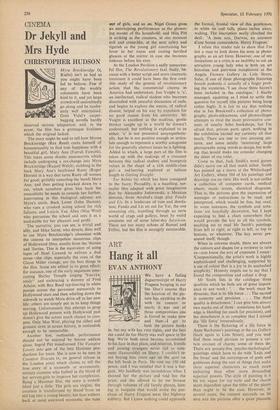ART
Hang it all
EVAN ANTHONY
We have a fading daguerreotype of Harry Fragson hanging in our loo. Don't assume that the location of the pic- ture has anything to do with its content or merit; it was one of those compromises one is forced to make now and then—I get to bash the picture hooks in, but my wife has veto rights, and the best she could do for Harry was wall space in the bog. We've both since become accustomed to his face in that place, and relatives, friends and passing strangers never fail to com- ment (favourably) on Harry. I couldn't re- sist buying him years ago on the quai on the left bank in Paris. He cost me 150 old pence, and I was satisfied that it was a bar- gain. My landlady was incredulous when I showed her the picture and .told her the price, and she offered to let me browse through volumes of old family photos, hint- ing at bargains that would make the pur- chase of Harry Fragson seem like highway robbery. But I knew nothing could approach
the formal, frontal view of this gentleman, in white tie and tails, piano inches away, waiting. The inscription really clinched the deal : 'A mon ami, Darwin, en souvenir d'une bonne camaraderie. Harry Fragson.'
I relate this tender tale to show that I'm not a man to look down his nose at photo- graphy as an art form. However, one of my limitations as a critic is an inability to ask an attractive young lady who is both an art historian and part-time receptionist at the Angela Flowers Gallery in Lisle Street, Soho. if one of three photographs featuring female pudenda is actually of a finger prob- ing the mysteries. 'I see those three haven't been included in the catalogue,' I finally managed, squinting as I tried to settle the question for myself (the pictures being hung rather high). It is fair to say that nothing else in Ian Breakwell's collection of photo- graphs, photo-silkscreens, and photocollages attempts to rival the more provocative con- tents of nearby Soho bookshops, but I'm afraid that, private parts apart, nothing in the exhibition excited my curiosity all that much. There are one or two amusing pic- tures, and some mildly 'interesting' large photographs using words as design, but noth- ing thal would make me consider changing the decor of my toilet.
Come to that, Jack Smith's word games didn't move me all that much either. Smith has painted up a storm at the Whitechapel Art Gallery, where 104 of his paintings and drawings are on view. His work is not unlike a collection of computer cards, medical charts, music scores, electrical diagrams. That is, the pictures give the impression of messages or instructions to be read; not interpreted, which would be fine, but read. In some instances, the symbols and nota- tions -are fancifully decorative, but I kept expecting to find a chart somewhere that would provide the key to all the symbols, enabling me to read Mr Smith's paintings from left to right, or right to left, or top to bottom, or whatever. The key never pre- sented itself, though.
When in extreme doubt, there are always the colours and shapes for a reviewer to turn to—you know the sort of comment I mean: 'Compositionally, the artist's work is highly sophisticated and challenging, supported by a use of colour that is a joy in its unabashed simplicity.' Honesty impels me to say that I found the composition and colour a drag.
Mr Smith lists in the catalogue three qualities which he feels are of great import-
ance to any work : . . the work must be dynamic, that is its life force ... The second is austerity and precision . . . The third quality is detachment.' 1 can give him almost two marks out of three : sometimes his hard- edge is bleeding (so much for precision), and the detachment is so complete that I missed the 'life force' tremendously.
There is the flickering of a • life force in Anne Buchanan's paintings at the ata Gallery (back again to Lisle Street), and you may find these small pictures to possess a cer- tain amount of charm; some of them do. There are seventy-five 'psycho-mythological' ' paintings which have to do with 'Leda and the Swan' and the carryings-on of gods and goddesses doing the sort of things that make these supernal characters so much more endearing than other more demanding supernal power's. The style of painting is a bit too vague for my .taste and the charm more dependent upon the titles of the pieces than ought to be the case; However, in several cases, the content succeeds on its own and the pictures offer a quiet pleasure,


































 Previous page
Previous page